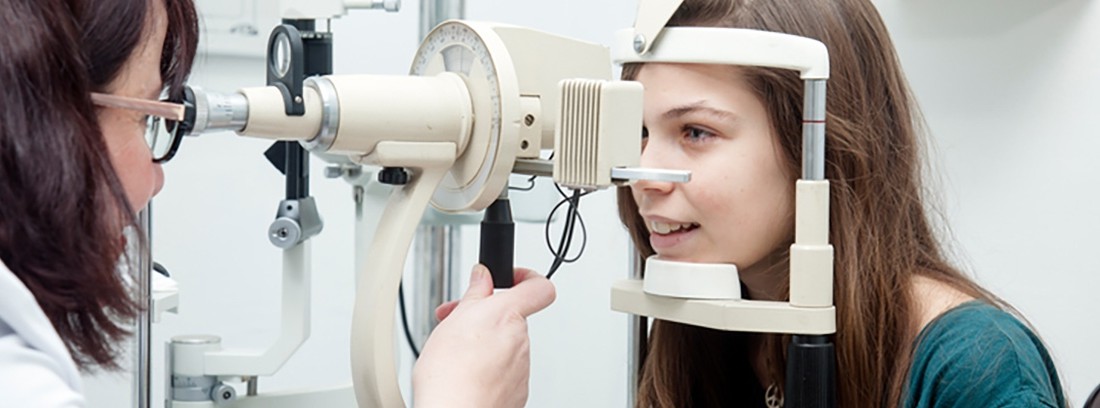Amblyopia

Each eye captures an image that is reflected in the retina and whose information is transmitted through the optic nerve to the cerebral cortex in charge of vision, which is located at the occipital level. The information obtained from each eye is overlaid to create a single image.
If, for some reason, there is a great difference in the visual acuity of the images captured by one eye and those of the other, the brain selects the sharpest image that provides the most information. In this way, the brain tends to enhance the information it receives from the dominant eye and discards the image from the weaker eye. If this is perpetuated, the part of the brain that receives visual information from the weak eye gradually stops working, maintaining the vision defect and making it irreversible. When this situation occurs it is said that the patient suffers from amblyopia.
How is it produced?
In the first years of life, the cerebral cortex develops and specializes thanks to the stimuli it receives. The visual cortex is located at the back of the brain. If the parts that receive visual information from one of the eyes are not stimulated correctly, their development is insufficient. If the defect is not corrected as soon as possible, after a while the brain loses its ability to adapt and the person is unable to recognize the images transmitted by that eye, even though the eye is anatomically normal and the nerve pathways are intact. The brain will not recognize images due to disuse from the visual cerebral cortex.
The main causes of amblyopia are:
- : one eye fixes better than the other, so the brain obtains two different images that it cannot superimpose and selects the sharpest one, enhancing the information from the dominant eye and canceling the information it receives from the more strabismus.
- Visual deprivation: caused by a congenital cataract, a clouding of the cornea, a drooping (ptosis) of the eyelid that makes it difficult for one eye to see, or a malformation that prevents adequate monocular vision. The brain acts in the same way: it selects the information it obtains from the healthy eye and rejects the distorted information received by the diseased eye.
- Anisometropia: is the difference in the refractive capacity between both eyes. When a patient is nearsighted or farsighted and the diopter difference is very high between the two eyes, the brain selects the image obtained by the least myopic or farsighted eye and ignores the information received by the other eye.
Symptoms
Amblyopia is a common disease that affects approximately 4% of the population. It is a process that affects young children, which can be difficult to detect. The child complains of not seeing well, seeing blurred or double, has difficulty concentrating or suffers when he tries to concentrate on a task (studying, reading, watching television ...).
Is often myopic or hyperopic children those who wear corrective glasses complain that, despite everything, their visual ability does not improve, especially in one eye.
Diagnosis
Early diagnosis is essential and requires the collaboration of parents and teachers. Faced with visual impairment, it is essential to take the child to the ophthalmologist to assess visual acuity, as well as to explore the fundus.
Strabismus can be seen with the naked eye, but myopia or astigmatism-type visual defects are more difficult to detect.
Treatment
Treatment consists of three axes:
- Detect the cause.
- Correct the defect.
- Promote the recovery of the stimulation capacity of the visual cortex of the eye affected by amblyopia.
In the case of congenital defects such as cataracts or corneal opacity, the patient should be intervened as soon as possible to minimize the effect of amblyopia. Strabismus may be attempted to be corrected by surgical intervention if necessary. In the case of refractive errors, glasses will be used to correct myopia or hyperopia.
Finally, it is convenient to stimulate the cortex of the weak eye and for that the healthy eye is occluded. In this way, the lazy eye has to "make an effort" to work and the cerebral cortex of that eye will be the only one that receives stimuli and, therefore, that develops correctly. It has been found that the best results are obtained by occluding the healthy eye 70-100% of the day. The occlusion has to be controlled by an ophthalmologist.
Precautionary measures
Amblyopia preventive measures are based on your early detection and correction of the defect causative and prompt stimulation of the affected area. The results in children under ten years of age are quite good, but after that age it is difficult to recover visual capacity, since the visual cerebral cortex has already lost its recognition capacity. In case of suspecting risk of amblyopia in children, especially in children with significant strabismus or marked anisometropia, it is essential to get in the hands of an ophthalmologist as soon as possible to start treating the cause and applying corrective therapy for amblyopia.
WHAT YOU SHOULD KNOW- Amblyopia is a common disease that affects 4% of the population, especially young children.
- Seeing blurry or double, having difficulty concentrating or having a headache when trying to concentrate on a task are symptoms of amblyopia.
- The treatment consists of stimulating the cortex of the weak eye by occluding the healthy one, so that the cerebral cortex of the lazy eye is the only one that receives stimuli and develops correctly.
(Updated at Apr 14 / 2024)